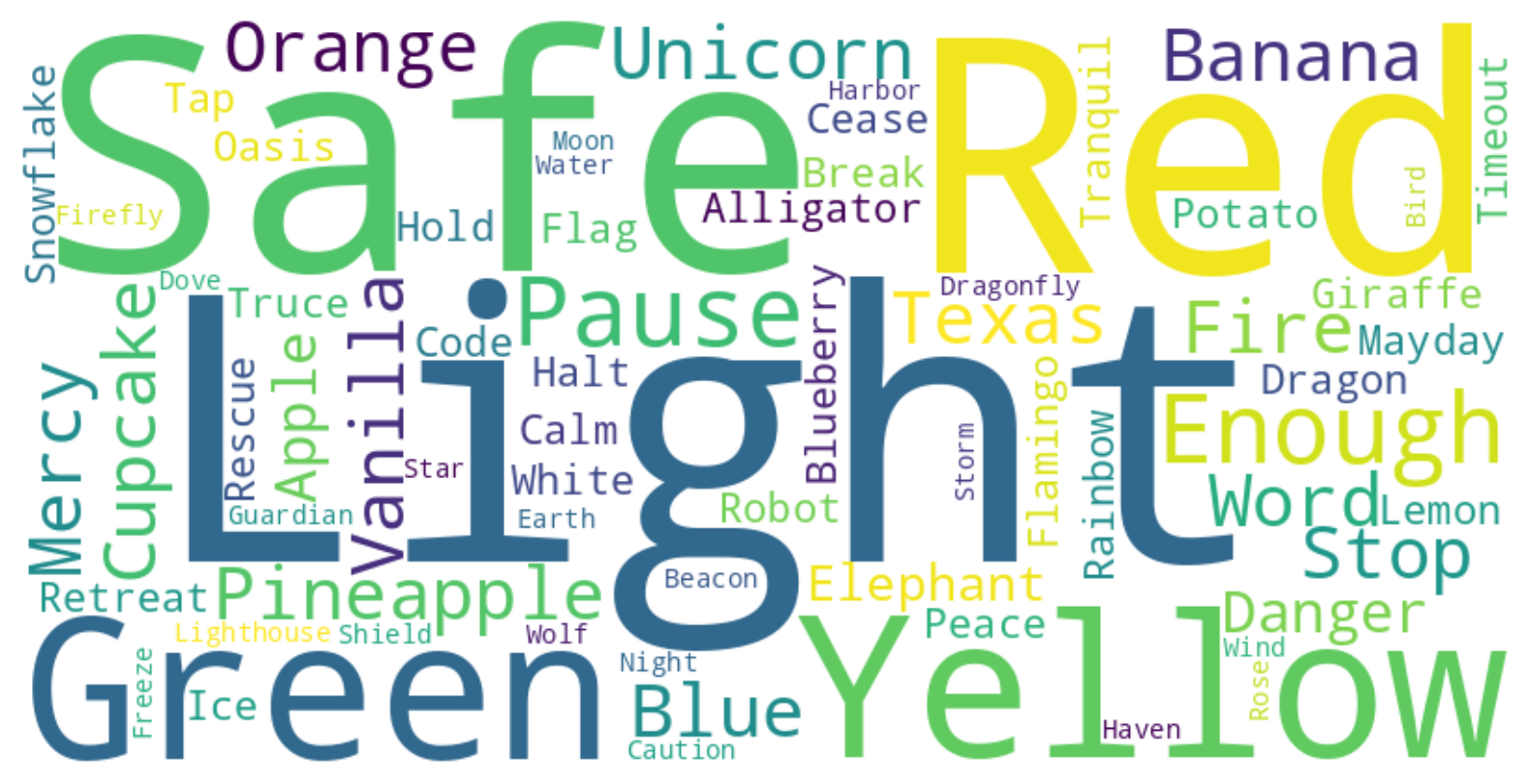Quill & Chill
Y is for Yellow

Safe words are a crucial component in ensuring safety and trust in various interactions, particularly in contexts where boundaries and consent are paramount, such as BDSM, therapy, and intimate relationships. Using colors as safe words, such as "yellow," provides a clear and easily understood system for communicating comfort levels. This article explores the significance of the color yellow as a safe word and its role in promoting effective communication and safety.
⚠️Understanding Safe Words⚠️
Definition and Purpose of Safe Words
Safe words are pre-agreed upon signals used to communicate one's comfort level or need to stop an activity immediately. They serve as a crucial tool in contexts where verbal consent is continuously required, such as BDSM, therapeutic settings, or even certain intense role-playing games. The primary purpose of safe words is to ensure that all participants can clearly express their limits, ensuring a safe and consensual environment.
The Role of Communication and Consent
Effective communication and mutual consent are the foundations of healthy interactions, especially in scenarios that involve physical or emotional boundaries. Safe words facilitate this communication by providing a clear, unambiguous way to express discomfort or the need to slow down. They help prevent misunderstandings and ensure that everyone involved feels secure and respected.
How Safe Words Contribute to Safety and Trust
The use of safe words fosters an environment of trust and safety. Participants can engage in activities knowing they have a reliable way to signal when something is too much. This trust is essential for any relationship or interaction involving intense or potentially risky activities. Safe words also empower individuals to take control of their boundaries, leading to more positive and fulfilling experiences.
⚠️The Color Code System⚠️
Explanation of the Color Code System
The color code system is a widely recognized method for using colors as safe words, with "green" meaning everything is fine to continue, "yellow" indicating the need to slow down or proceed with caution, and "red" signifying an immediate stop. This system is particularly effective because it provides a simple and intuitive way to communicate varying levels of comfort and urgency.
Historical Background and Development
The color code system has its roots in traffic signals and emergency codes, which use colors to convey important information quickly and efficiently. Over time, this system was adopted in various domains where clear, immediate communication is essential. In the context of safe words, the color code system offers a universal language that can be easily understood by all parties involved.
Benefits of Using Colors Over Words
Using colors as safe words has several advantages over traditional verbal cues. Colors are universally recognizable and can be processed quickly, reducing the chances of miscommunication. They also transcend language barriers, making them ideal for situations involving participants from different linguistic backgrounds. Additionally, colors can be more memorable and easier to recall in moments of high stress or intensity.
⚠️Why Yellow?⚠️
Symbolism and Psychology of the Color Yellow
Yellow is often associated with caution, attention, and alertness. These associations make it an ideal choice for a safe word indicating the need to slow down or proceed with caution. Psychologically, yellow can invoke feelings of warmth and clarity, ensuring that the signal is both noticeable and memorable. Its bright and vibrant nature makes it stand out, reducing the risk of misinterpretation during intense or high-stress situations.
Yellow as a Middle-Ground Signal
In the color code system, yellow serves as a middle-ground signal between "green" (all good) and "red" (stop immediately). It allows participants to communicate discomfort or the need for a break without abruptly halting the activity. This flexibility can help maintain the flow of the interaction while ensuring that everyone's boundaries are respected.
Practical Reasons for Choosing Yellow
From a practical standpoint, yellow is an excellent choice because it is universally recognized and easy to remember. It stands out visually and conceptually, making it an effective signal in various settings. Additionally, yellow is not commonly used as a safe word in everyday language, reducing the likelihood of confusion or accidental use.
⚠️Using Yellow as a Safe Word⚠️
Situations Where "Yellow" Is Commonly Used
"Yellow" is commonly used in BDSM and other consensual activities to signal that the current pace or intensity needs to be adjusted. It is also utilized in therapeutic settings, such as trauma therapy or role-playing exercises, where participants may need to communicate discomfort without stopping the session entirely. This safe word helps ensure that activities remain consensual and within the comfort zone of all involved.
How to Respond When Someone Uses "Yellow"
When someone uses "yellow," the appropriate response is to immediately acknowledge the signal and adjust the activity accordingly. This may involve slowing down, reducing intensity, or pausing to check in with the participant. It is crucial to communicate openly and ensure that the person who used the safe word feels heard and respected.
Examples of Dialogue and Scenarios
🚧Scenario: During a BDSM session, one partner feels the intensity is becoming overwhelming.
🚧Dialogue: "Yellow, please. Can we slow down for a moment?"
🚧Response: "Of course. Let's take a break and see how you're feeling."
🚧Scenario: In a role-playing therapy session, a participant starts to feel uncomfortable.
🚧Dialogue: "Yellow. I need a moment."
🚧Response: "Thank you for letting me know. Let's pause and discuss what's going on."
Implementing Safe Words Effectively
Establishing Safe Words in Relationships and Sessions
To implement safe words effectively, it is essential to establish them clearly at the beginning of any interaction that may require them. This involves discussing and agreeing on the specific words or signals to be used, ensuring that all participants understand their meanings and implications. Regularly revisiting and reinforcing these agreements can help maintain their effectiveness.
Importance of Discussing and Agreeing on Safe Words
Discussing and agreeing on safe words is a critical step in establishing trust and mutual understanding. It ensures that everyone involved knows how to communicate their boundaries and what to expect when a safe word is used. This discussion should be open, honest, and include all participants to ensure that everyone's needs and concerns are addressed.
Training and Practice in Using Safe Words
Training and practice are essential for effectively using safe words. This can involve role-playing scenarios, practicing responses, and regularly discussing safe words in a non-pressured environment. By making safe words a regular part of interactions, participants can become more comfortable and confident in using them when needed.
⚠️Psychological Impact⚠️
How Safe Words Affect Mental Health and Well-being
Safe words significantly contribute to mental health and well-being by providing a clear mechanism for expressing discomfort or distress. They empower individuals to take control of their experiences, which can reduce anxiety and increase confidence. Knowing that they can halt or adjust an activity at any time helps participants feel safer and more secure, fostering a positive mental state.
Reducing Anxiety and Building Trust
The use of safe words can greatly reduce anxiety by creating a predictable and reliable way to communicate boundaries. This predictability builds trust between participants, as they can be confident that their signals will be respected. Over time, this trust can deepen relationships and enhance the overall experience, whether in a BDSM setting, therapy, or other scenarios.
Studies and Expert Opinions on Safe Word Usage
Research and expert opinions consistently highlight the importance of safe words in promoting safety, trust, and consent. Studies show that clear communication tools like safe words can significantly reduce the risk of harm and enhance the psychological well-being of participants. Experts in psychology, therapy, and the BDSM community advocate for the regular use and reinforcement of safe words to maintain a safe and respectful environment.
⚠️Cultural and Contextual Variations⚠️
Safe Word Usage in Different Cultures
The concept and application of safe words can vary significantly across different cultures. While the principles of consent and communication are universal, cultural norms and values influence how safe words are used and understood. For example, some cultures may have specific traditional phrases or signals that serve similar purposes, while others might adopt the color code system more readily.
Adapting Safe Words for Various Situations
Safe words are versatile and can be adapted for a wide range of situations beyond their typical contexts. In addition to BDSM and therapy, safe words can be useful in professional environments, intense training sessions, or any scenario where clear communication of limits is necessary. Adapting safe words involves ensuring they are contextually appropriate and understood by all parties involved.
Legal and Ethical Considerations
There are important legal and ethical considerations when implementing safe words, especially in professional or therapeutic settings. Ensuring that all participants are fully informed about the use of safe words and their implications is crucial. Additionally, respecting and responding appropriately to safe words is not only an ethical obligation but may also have legal ramifications in certain contexts.
⚠️Common Misconceptions⚠️
Myths About the Effectiveness of Safe Words
There are several myths and misconceptions about the effectiveness of safe words. Some believe that safe words are unnecessary or overly cautious, while others think they disrupt the natural flow of interactions. These misconceptions can undermine the important role safe words play in ensuring safety and consent. Addressing these myths involves educating participants about the benefits and necessity of safe words.
Addressing Skepticism and Misunderstandings
Addressing skepticism and misunderstandings about safe words requires open communication and education. Providing clear explanations, real-life examples, and expert insights can help demystify safe words and emphasize their importance. Encouraging participants to share their experiences and concerns can also foster a better understanding and acceptance of safe words.
Real-life Case Studies and Testimonials
Real-life case studies and testimonials provide powerful evidence of the positive impact of safe words. Sharing stories of individuals who have successfully used safe words to navigate difficult situations can illustrate their effectiveness and encourage others to adopt similar practices. These narratives can also highlight the diverse contexts in which safe words can be beneficial.
⚠️Challenges and Solutions⚠️
Potential Challenges in Using Safe Words
Despite their benefits, using safe words can sometimes present challenges. Participants may forget the agreed-upon safe words, especially under stress. Miscommunication or misinterpretation of safe words can also occur, potentially leading to unintended consequences. Additionally, some individuals may feel embarrassed or reluctant to use safe words, fearing it might disrupt the interaction or be perceived negatively.
Solutions and Strategies for Overcoming These Challenges
To overcome these challenges, regular reinforcement and practice are crucial. Participants should periodically review and practice safe words in low-pressure environments to build familiarity. Clear and ongoing communication about the importance and function of safe words can alleviate embarrassment and encourage their use. Establishing a supportive atmosphere where using safe words is normalized and respected can also help.
Importance of Ongoing Communication
Ongoing communication is essential for the effective use of safe words. Participants should feel comfortable discussing their boundaries and any changes in their comfort levels. Regular check-ins before, during, and after interactions can ensure that safe words are understood and used appropriately. This continuous dialogue helps maintain a safe and respectful environment.
⚠️Safe Words Beyond the Bedroom⚠️
Use of Safe Words in Therapy and Counseling
Safe words are valuable tools in therapy and counseling, particularly in modalities that involve role-playing or intense emotional work. They allow clients to communicate their comfort levels and need for breaks, ensuring a safe and supportive therapeutic environment. Therapists can use safe words to gauge clients' readiness to proceed and adjust the session accordingly.
Safe Words in Professional and Everyday Settings
Beyond intimate and therapeutic contexts, safe words can be applied in various professional and everyday settings. For instance, in high-stress workplaces or training programs, safe words can signal the need for a pause or adjustment. They can also be useful in family dynamics, helping members communicate discomfort or the need to de-escalate conflicts.
Expanding the Concept of Safe Words
The concept of safe words can be expanded to include non-verbal signals, especially in situations where verbal communication is difficult or impossible. Hand gestures, visual cues, or even predetermined signals in digital communication can serve as effective safe words. This flexibility ensures that the principles of clear communication and consent are upheld in diverse scenarios.
⚠️Expert Insights⚠️
Interviews with Psychologists, Therapists, and Practitioners
Expert insights from psychologists, therapists, and practitioners can provide valuable perspectives on the use of safe words. These professionals can share their experiences and strategies for implementing safe words effectively. Interviews and discussions with experts can also highlight the importance of safe words in promoting mental health and well-being.
Advice from Experts on Implementing and Respecting Safe Words
Experts recommend clear and thorough discussions about safe words before engaging in any activity that might require them. They emphasize the importance of mutual understanding and respect for these signals. Practitioners also advise regular check-ins and debriefings to ensure that safe words are used correctly and that all participants feel heard and respected.
Future Trends in Safe Word Usage
The future of safe word usage may involve greater integration of technology and innovative communication methods. For example, wearable devices could be programmed to signal safe words non-verbally. As awareness and understanding of the importance of consent and communication grow, safe words will likely become more widely adopted in various contexts.
⚠️Personal Stories and Experiences⚠️
Anecdotes from Individuals About Their Experiences with Safe Words
Personal stories can provide powerful illustrations of the importance and impact of safe words. For example, one individual might share how using "yellow" in a BDSM session allowed them to communicate their need to slow down without feeling pressured to stop completely. Another might describe how safe words helped them navigate difficult therapy sessions, providing a sense of control and safety.
Lessons Learned and Personal Growth
Through the use of safe words, many individuals experience significant personal growth. They learn to assert their boundaries, communicate more effectively, and build deeper trust in their relationships. These lessons often extend beyond the specific context in which safe words were used, contributing to overall personal development and improved interpersonal skills.
Impact of Safe Words on Relationships
Safe words can profoundly impact relationships by fostering a culture of consent and mutual respect. Couples or partners who regularly use safe words often report stronger communication and a greater sense of safety and trust. This practice can enhance intimacy and connection, as both parties feel secure in expressing their needs and boundaries.
⚠️Educational Resources⚠️
Books, Articles, and Websites for Further Reading
Numerous resources are available for those interested in learning more about safe words and their implementation. Books such as "The New Topping Book" and "The New Bottoming Book" by Dossie Easton and Janet W. Hardy provide comprehensive guides. Articles on websites like Psychology Today and various BDSM community forums offer valuable insights and advice.
Workshops, Courses, and Training Programs
Many organizations offer workshops, courses, and training programs focused on safe word usage and effective communication. These programs can be particularly beneficial for individuals new to BDSM, therapy, or other contexts where safe words are used. They provide practical, hands-on experience and expert guidance to ensure participants feel confident and informed.
Support Groups and Communities
Support groups and communities, both online and offline, can be invaluable resources for individuals exploring the use of safe words. These groups offer a space to share experiences, seek advice, and find support from others with similar interests and concerns. Communities like FetLife, therapy support groups, and local BDSM clubs can provide a sense of belonging and shared learning.
Safe words are a vital tool for ensuring safety, consent, and effective communication in various contexts. The color yellow, with its associations of caution and attention, serves as an ideal signal for slowing down or proceeding with caution. By understanding and implementing safe words like "yellow," individuals can create safer, more respectful, and more fulfilling interactions. Embracing the use of safe words not only enhances personal experiences but also builds trust and strengthens relationships. Whether in intimate settings, therapy, or everyday life, the practice of using safe words underscores the importance of clear communication and mutual respect.
⚠️FAQs⚠️
🚧What is a safe word, and why is it important?
A safe word is a pre-agreed signal used to communicate discomfort or the need to stop an activity immediately. It is crucial for ensuring safety, consent, and clear communication in various interactions.
🚧Why is yellow used as a safe word?
Yellow is used as a safe word because it symbolizes caution and the need to slow down. It serves as a middle-ground signal between continuing and stopping, allowing for adjustments without halting the activity entirely.
🚧Can safe words be used outside of BDSM?
Yes, safe words can be used in many contexts, including therapy, intense training sessions, professional environments, and everyday interactions where clear communication of boundaries is necessary.
🚧How can I effectively implement safe words in my relationship?
To effectively implement safe words, discuss and agree on them with your partner(s) before engaging in any activity that might require them. Regularly reinforce and practice using them, and maintain open communication about boundaries and comfort levels.
🚧Are there non-verbal alternatives to safe words?
Yes, non-verbal alternatives to safe words, such as hand signals, visual cues, or predetermined digital signals, can be used in situations where verbal communication is difficult or impossible. These alternatives ensure that the principles of consent and clear communication are upheld.












